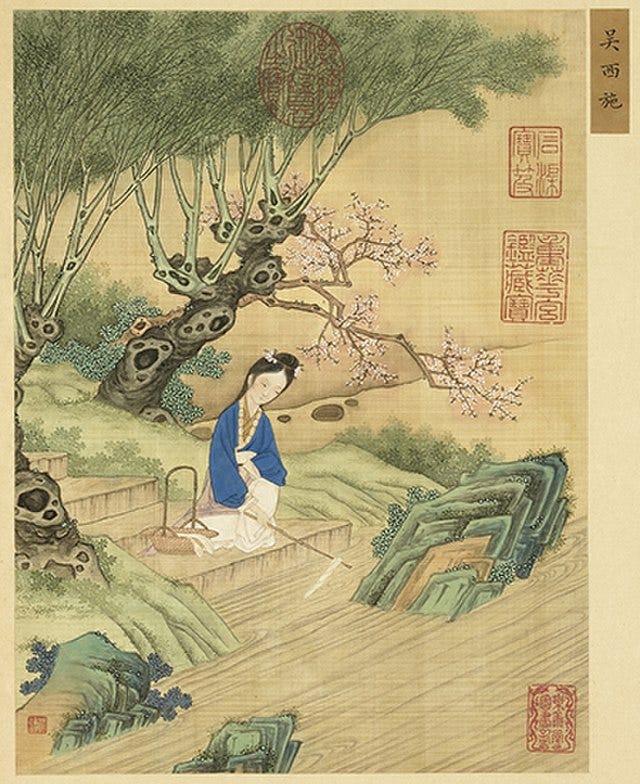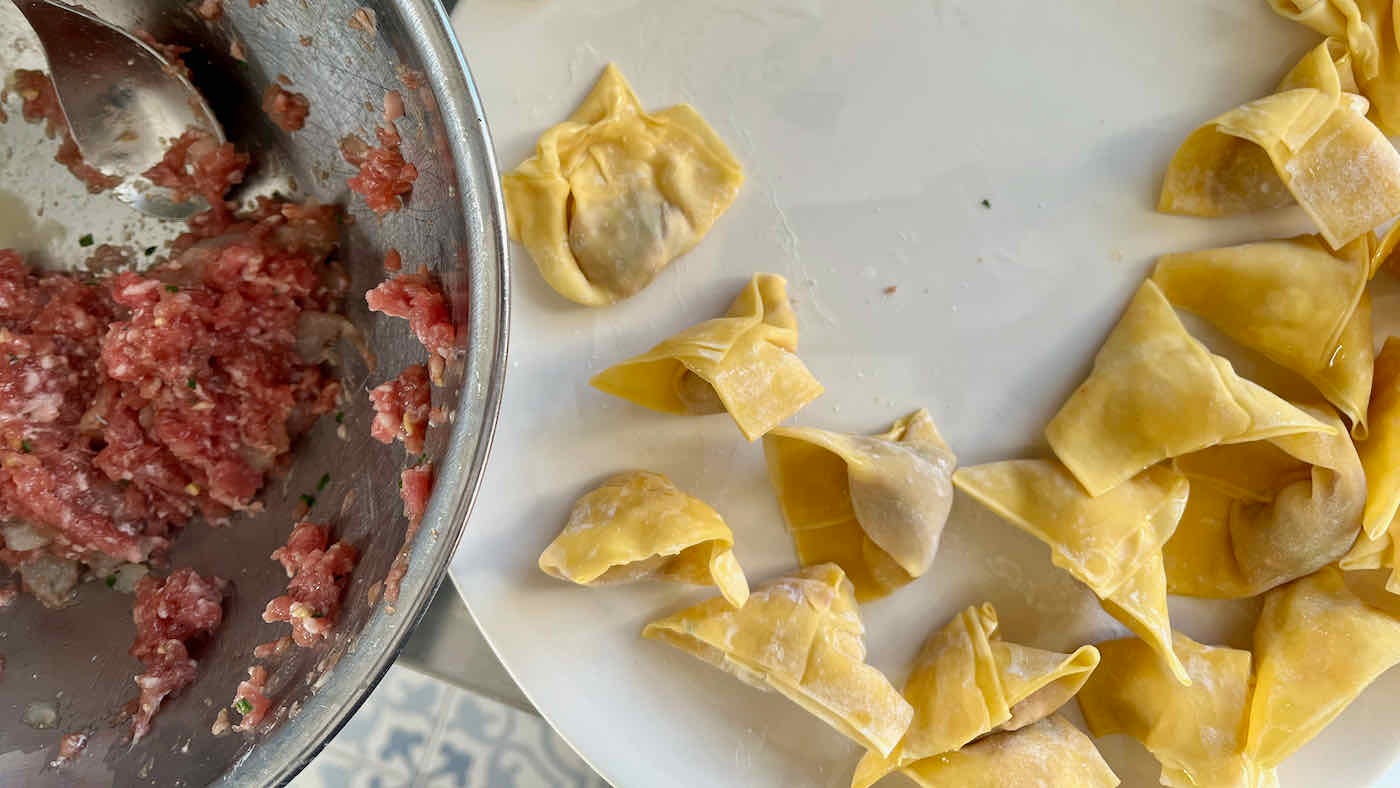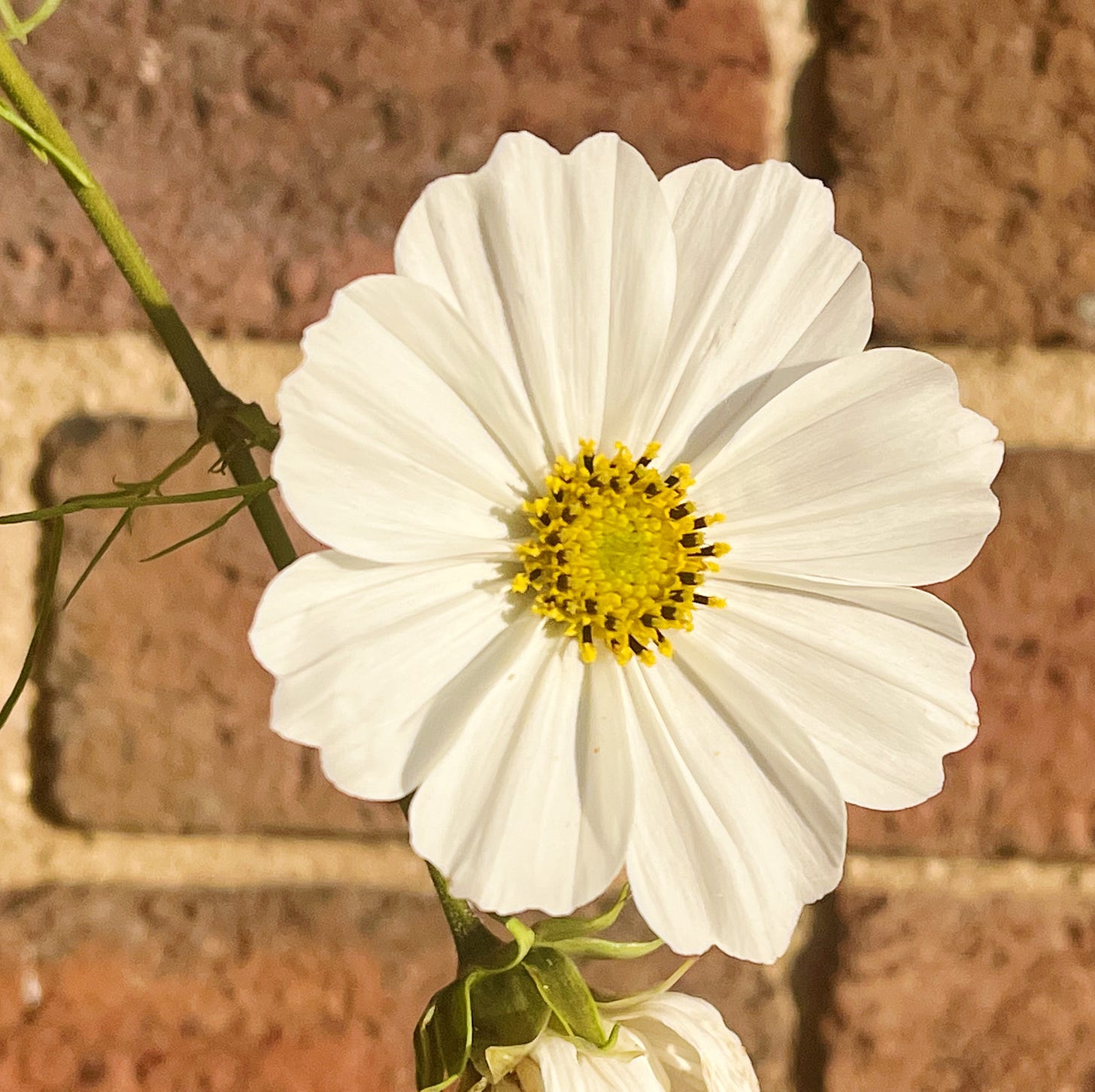Chaos Dumplings
Some fragmented thoughts on wonton, ancient Chinese legends, All Souls Day, and talking about hope and love
Wednesday, November 2
Grand Rapids, Mich.
Good morning, dear reader.
I’m sending this week’s letter earlier than usual because I’m off to Texas tomorrow for a speaking engagement as well as to cook for a friend. Look at my luggage—it’s ridiculous, even by my standards.
When I get to my friend’s home, I will make some wonton.
Last weekend, Tristan’s sister and brother-in-law were here for a visit. (If you ask me, Lari’s primary motivation was to visit Fozzie, but we were glad to see her too.) I’d never had the chance to cook for them before. So on Saturday evening, I made a Chinese dinner—soy-marinated bavette steak, vegetable stir fry, braised mushrooms with bok choy from our backyard, halibut with ginger and scallion, and vegetable fried rice.
Of course I also made some fried wonton, because what’s not to like about a nugget of marinated pork enrobed by crispy goodness? Then I wrapped some dumplings to stash in the freezer for an easy weeknight meal.
Wonton are incredibly versatile. You can fry them, or you can bathe them in spicy chili oil, or you can let them swim in a rich broth with noodles and greens. All good! The filling is usually pork, but sometimes it’s pork and shrimp. A few years ago, when I went to a wonton shop in Hong Kong that my parents have been eating at since they were kids, I realized that they don’t bother with the pork at all—it’s all shrimp.
On Saturday, I did pork and shrimp. I minced some ginger as well as chives from the backyard. Then I seasoned it all with soy sauce and sesame oil, salt and pepper, adding and stirring until it hit all the right notes in my olfactory memory—just like my childhood.
The ones destined for frying don’t really take much wrapping at all. You just put a dollop of filling in the center of a wrapper (Twin Marquis brand, Hong Kong-style, available in most Asian grocery stores—I don’t know anyone who makes their own). And then you fold diagonal corners together to form a triangle. The ones meant for soup require a bit more thought and effort—fold bottom to top to make a rectangle, then the top corners together to create a little bonnet.
(I realize that this is nothing resembling a recipe, even according to my usually vague measures. If you’d like to try making your own wonton and your faith in the above instructions is such that you’d like something a bit clearer and more precise, a while back I wrote up a recipe for fried wonton and The Woks of Life, which has consistently provided me with excellent recipes for Chinese dishes I don’t know how to cook, has instructions for making a fine Cantonese-style wonton noodle soup here.)
This is obviously not just about the food. There’s something deeply comforting to me about making wonton. Even as I fold the filling into the dumpling, I feel as if I’m being enfolded into a story much larger than my own. I learned how to wrap wonton from my mother, and I imagine she learned from her mother, and onward through the generations. This isn’t necessarily women’s work either: I remember standing around my uncle’s kitchen table in Hong Kong, everyone making dumplings together.
The other day, as I filled and folded and tucked, I wondered how many generations of my ancestors learned these same skills from their elders. How many kitchens? How many centuries of stories have been passed down as hands grew sticky with egg and flour? How many seasons of change have been marked by the return to these familiar and comforting traditions?
People in China have been eating wonton for millennia, and there are myriad legends about how the dumplings came to be.
One legend claims that, in olden days, people in northern China were living under the oppression of a foreign tribe of warriors. Two of the invading warriors, Hun and Dun, were said to be especially cruel. In quiet resistance, the people made dumplings. They named them Hun and Dun. And then they ate them, hoping that this act would presage the coming of freedom and peace.
Another tradition holds that wonton were created to be shaped like the moon. The coming of the first new moon after the winter solstice would be the occasion to make and eat these dumplings as an act of honoring the ancestors.
My favorite wonton origin story is one about Xi Shi, an ancient woman said to be so entrancingly beautiful that geese would set eyes upon her and fall from the sky. About 2,500 years ago, China wasn’t China; it was a collection of warring states with constantly shifting borders. The Wu State, which sat just south of the Yangtze River on the eastern coast of China, was the domain of a feckless king with little interest in good governance.
The leaders of the neighboring state of Yue sent Xi Shi to the Wu king as a secret agent. She seduced the king with little dumplings that she called 渾沌 (hundun), which means “chaos.” She claimed that this described the haphazard way in which she had wrapped the dumplings. But how could it have been anything but a commentary on his rule?
Distracted by the dumplings—really, let’s be honest, by the dumpling maker—the king made a series of poor strategic moves, and Yue soon conquered and annexed Wu.

Of course, there was no way that people would just keep eating chaos dumplings. Over time, the name evolved into the much more poetic 雲吞, which in my native Cantonese is pronounced “wuntun,” which got transliterated into the English “wonton.” It literally means “swallowing a cloud.”
There’s something resonant about eating what was once a chaos dumpling and finding momentary goodness and ethereal beauty in it. To live up to the wonton’s name, the filling, while substantial, should never be too dense. At times I’ve played with the recipe. I’ve made wonton with ground beef, if I know a guest at my table doesn’t eat swine flesh. Once, I did a version with duck. For vegetarian friends, shiitake mushrooms and greens work too.
If I’m cooking for my tastes, though, I’ll always return to the familiar and the traditional. To do it the way I learned from my mother is to find steadiness, I suppose, in the solidarity of the ancestors. As the dumplings pile up on a plate, I rebuke the lie of isolation that can be so tempting and remember that my forebears are still with me. I remember happy moments from my childhood—the sound of laughter and the scent of simmering stock in the kitchen, my mother lovingly chiding me for my careless technique, my grandmother humming an old hymn tune.
There’s something encouraging about recalling how, through all sorts of seasons, my people kept making wonton. And there’s something grounding in doing what they have done since time immemorial: filling and folding, transforming and feeding, delighting and surviving.
What I’m Reading: All Souls Day wasn’t a thing in the church tradition I was reared in. Indeed, remembering those who came before was more a part of my ethnic heritage than it was an aspect of my childhood Christianity. It’s only in my adulthood that I’ve found the congruence between the two.
For All Souls Day, my friend Sarah Bessey wrote what I think is one of her best, most moving essays. “The Beautiful, Haunted Landscape” is a gorgeous reflection on grief and love, inspired by her return to Montreat, where Evolving Faith 2018 was held. “Whatever we need to do to keep going is just what we did to keep going. And that’s okay,” she writes. “It’s okay right up until it isn’t anymore and then it’s time to befriend our ghosts. It’s eventually time to integrate the loss and the grief and trauma with the laughter and the love and the gratitude, to learn to hold all of it within your soul, to become the haunted and beautiful landscape yourself.”
Whew.
What I’m Growing: My tulip and daffodil bulbs for next season are ready to plant. But we’ve had such weird weather. Though some nights have crept toward freezing, the high tomorrow is going to be a balmy 73 degrees. Which means that I managed to cut some cosmos from the yard last weekend, and yesterday, I went out and spotted this flower. These days, any glimpse of unexpected beauty feels like a tremendous grace.
Prayers and good vibes welcome as I travel to Dallas. Because of my marriage, I am decidedly more of a Houston person than a Dallas one. Still, I’m really looking forward to stuffing my face with queso, and I’ve already placed a pre-order for a whole brisket to bring home. If you’re ever in Dallas, Cattleack BBQ is outstanding.
I will be speaking at a conference hosted by CenterPeace, a lovely organization that works to expand belonging for LGBTQIA+ people in the Church. Truth is, I’m a little tired of talking about faith and sexuality. Sometimes it feels as if those of us who identify both as gay and Christian don’t get to be whole humans; we have to focus mainly on one aspect of who we are. (It’s a little bit funny to me that this gathering comes just after Halloween too. I haven’t dressed up for Halloween for eons, partly because after so many years of pretending to be someone I wasn’t, I’m still doing my best to figure out how to be my true self every single day.)
At the same time, if I’m asked to bring a good and hopeful word, I have to try. LGBTQIA+ folks remain so vulnerable to marginalization, especially in the Church. And if I have an opportunity to remind people that we are loved—and that we are therefore called to love—what kind of jerk would I be if I turned that down?
Anyway, as I said, prayers and good vibes are welcome. What can I be praying for on your behalf? I’d love to know, too: What are the things you cook that connect you to your people and to your heritage?
As always, I’m so glad we can stumble through all this together, and I’ll try to write again soon.
Yours,
Jeff








I grew up with three different fathers, in 14 places before I turned 15. Not a lot of cultural identity. But I married a wonderful man with a large Italian family, including a Sicilian great grandmother who taught me to make ravioli. Almost 50 years later, I still make it on special occasions. Every time,I thank God for the gift of a stable family where food is a celebration and recipes are passed along.
This is such lovely imagery in reading about your cooking Jeff. Your spirituality of cooking also comes through clearly. I remember when my Chinese wife suffered through won ton and dumpling making lessons with me and my undexterous American fingers. I also remember when my mother-in-law would meet our son after school and before swim practice with a basket of dumplings. There is a great scene in "Crazy Rich Asians" where the kids and Moms are gathered around the table to make dumplings. "And then you eat the baby." If ever in Houston check out Goode and Company for their barbecue and puh-kahn pie. You might just want to thank your lucky stars, that you're from Texas. Your essay made me think if people stopped and shared a meal (preparing, cooking and eating) they might be less likely to hate. Safe travels and bon Appetit.